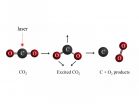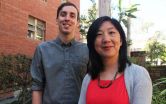(Press-News.org) Scientists at the University of Granada, in collaboration with La Paz University Hospital in Madrid and the University of Texas, San Antonio in the US have demonstrated through several experiments conducted on Zucker obese rats that chronic consumption of melatonine helps combat obesity and diabetes mellitus type two.
Their research has confirmed that chronic administration of melatonine in young obese rats with diabetes mellitus type two, similar to its human equivalent, improves mitochondrial dysfunction (i.e. mitochondrial homeostatic functions) in a very efficient way, since it improves the consumption of oxygen, it diminishes the levels of free-radicals stress and prevents the destruction of the mitochondrial membrane.
These results, published in the last issue of the prestigious Journal of Pineal Research, confirm other similar studies conducted by these researchers during the last three years.
This research has been conducted by an interdisciplinary team from the Farmacology Department and the Neuroscience Institute, University of Granada, led by prof. Ahmad Agil, with the collaboration of Dr. Gumersindo Fernández, from the Endocrinology and Nutrition Service of La Paz University Hospital in Madrid, and prof. Russell Reiter, from the Structural Biology Department at the University of Texas, in San Antonio (USA)
According to the PI, prof. Ahmad Agil, both developed and developing countries currently evince a significant increase in obesity rates and also in diabetes type two. This increase results from a maladaptation of the human genome to modern environments, sedentary lifestyles, higher consumption of hypercaloric food and excessive exposure to artificial lightning, which reduce endogenous melatonine levels.
In the case of obesity, mitochondriae (our cells' power stations) do not work properly (homeostatic imbalance) and their programmed destruction is thus accelerated (apoptosis). This leads to insuline resistance and the subsequent development of diabetes mellitus.
We must sleep in total darkness
In prof. Agil's words, melatonine "is a natural substance present in plants, animals and humans; it works as a hormonal signal released during the night to establish circadian rhythms"
Currently this process is frequently interrupted, as a result of excessive exposure to artificial lightning during the night, which reduces the levels of endogenous melatonine—for instance, many people are in the habit of sleeping with their lamps, TVs or their computers switched on, or with the blinds drawn up. "For all these reasons, it is important to try to sleep in absolute darkness, to avoid interference in the generation of melatonine".
Melatonine is a powerful antioxidant and anti-inflammatory: these properties constitute the foundation of its protective effect upon metabolism. 'Melatonine is particularly abundant in vegetables, such as spices, herbs, tea, coffee, fruit, seeds and nuts. This is one of the main reasons why these sorts of food are particularly healthy'
General treatments with specific action upon adipose tissue, and in particular upon the mitochondria, and the increase in their efficiency, could have beneficial effects upon these sorts of diseases.
INFORMATION:
This study has been funded and supported by several projects from the Ministry of Economy and Competitiveness (Spain, Ref: SAF2013-45752), the GREIB MCI-International Excellence Campus of the Vice-rectorage of Research and Scientific Policy at the University of Granada, and the CTS-109 research group (Junta de Andalucía), Spain.
Social network analysis could improve knowledge sharing in the healthcare sector, according to research results published in the International Journal of Collaborative Enterprise.
Elizabeth Cudney, Steven Corns and Suzanna Long in the department of Engineering Management and Systems Engineering at Missouri University of Science and Technology, in Rolla, Missouri, USA, explain how knowledge management systems (KMS) can be critical in capturing, retaining and communicating project results and staff knowledge. They can prevent knowledge drain and provide training as "lessons ...
Researchers at the University of Granada have designed a new imaging system capable of obtaining up to twelve times more colour information than the human eye and conventional cameras, which implies a total of 36 colour channels. This important scientific development will facilitate the easy capture of multispectral images in real time, and in the not too distant future it could also be used to develop new asisted vehicle driving systems, identify counterfeit bills and documents or obtain medical images much more accurate than current ones, among many other applications.
The ...
Many of those who are genetically predisposed to develop atrial fibrillation, which dramatically raises the risk of stroke, can be identified with a blood test. This is shown by new research from Lund University in Sweden.
The number of people affected by atrial fibrillation is rising rapidly, partly as a result of the ageing population.
Over recent years, a research group at Lund University in Sweden, working with other universities and hospitals in Europe and the USA, has identified twelve genetic variants in the human genome that increase the risk of atrial fibrillation. ...
Johnny Depp has an unforgettable face. Tony Angelotti, his stunt double in "Pirates of the Caribbean," does not. So why is it that when they're swashbuckling on screen, audiences worldwide see them both as the same person? Scientists from the University of California, Berkeley, have cracked that mystery.
Researchers have pinpointed the brain mechanism by which we latch on to a particular face even when it changes. While it may seem as though our brain is tricking us into morphing, say, an actor with his stunt double, this "perceptual pull" is actually a survival mechanism, ...
yphoon Phanfone's eye appeared the size of a pinhole on visible imagery from NASA's Aqua satellite on Oct.3.
The MODIS instrument or Moderate Resolution Imaging Spectroradiometer that flies aboard NASA's Aqua satellite captured a visible image of Phanfone moving through the Northwestern Pacific Ocean on Oct. 3 at 4:20 UTC (12:20 a.m. EDT). The tiny open eye of the storm was surrounded by a thick band of thunderstorms. The MODIS image also showed a very thick and large band of thunderstorms south of the center and spiraling into the eye.
On Thursday, Oct. 2, Typhoon ...
VIDEO:
Mexico's western coast is again dealing with rain, wind and rough surf from another tropical storm. NOAA's GOES-West satellite saw the formation of Tropical Storm Simon on Oct. 2. A...
Click here for more information.
Mexico's western coast is again dealing with rain, wind and rough surf from another tropical storm. NOAA's GOES-West satellite saw the formation of Tropical Storm Simon on Oct. 2. A NASA animation of NOAA's GOES-West satellite imagery shows the development ...
About one-fifth of the Earth's atmosphere is oxygen, pumped out by green plants as a result of photosynthesis and used by most living things on the planet to keep our metabolisms running. But before the first photosynthesizing organisms appeared about 2.4 billion years ago, the atmosphere likely contained mostly carbon dioxide, as is the case today on Mars and Venus.
Over the past 40 years, researchers have thought that there must have been a small amount of oxygen in the early atmosphere. Where did this abiotic ("non-life") oxygen come from? Oxygen reacts quite aggressively ...
Curiosity helps us learn about a topic, and being in a curious state also helps the brain memorize unrelated information, according to researchers at the UC Davis Center for Neuroscience. Work published Oct. 2 in the journal Neuron provides insight into how piquing our curiosity changes our brains, and could help scientists find ways to enhance overall learning and memory in both healthy individuals and those with neurological conditions.
"Our findings potentially have far-reaching implications for the public because they reveal insights into how a form of intrinsic motivation ...
White Americans may view diversity and multiculturalism more negatively as the U.S. moves toward becoming a minority-majority nation, UCLA psychologists report.
As part of their study, the researchers divided 98 white Americans from all regions of the country — half male, half female, with an average age of 37 — randomly into two groups. One group was told that whites will no longer be the majority in the U.S. by 2050; in fact, this is likely to be true as soon as 2043, according to some projections. The second group was told that whites would retain their majority status ...
BELLINGHAM, Washington, USA -- New applications of structures and materials that replicate complex yet efficient arrangements that have evolved in nature over millennia are featured in a special section on biomimetic and bioinspired materials for applications in biophotonics in the October issue of the Journal of Biomedical Optics. The journal is published by SPIE, the international society for optics and photonics, in the SPIE Digital Library. Several of the peer-reviewed articles are accessible via open access.
"Biomimetic and bioinspired materials present an emerging ...






